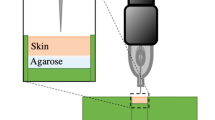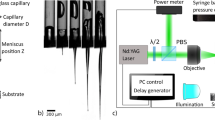Abstract
Injections into or through the skin are common drug or vaccine administration routes, which can be achieved with conventional needles, microneedles, or needle-free jet injections (NFJI). Understanding the transport mechanism of these injected fluids is critical for the development of effective drug administration devices. NFJI devices are distinct from traditional injection techniques by their route and time scale, which relies on a propelled microjet with sufficient energy to penetrate the skin surface and deliver the drug into the targeted region. The injected fluid interacts with multiple skin tissue layers and interfaces, which implies that the corresponding injection profile is dependent on their mechanical properties. In this study, we address the lack of fundamental knowledge on the impact of these interfaces on the injection profiles of NFJI devices.
Graphical abstract










Similar content being viewed by others
Availability of data and materials
The data and materials that support the findings of this study are available from the corresponding author upon reasonable request.
References
Hettinga J, Carlisle R. Vaccination into the dermal compartment: techniques challenges and prospects. Vaccines. 2020;8:534. https://doi.org/10.3390/vaccines8030534.
Weniger BG, Papania MJ. Alternative vaccine delivery methods Vaccines. 2013;2013:1200–31. https://doi.org/10.1016/B978-1-4557-0090-5.00063-X.
Guillot AJ, Cordeiro AS, Donnelly RF, Montesinos MC, Garrigues TM, Melero A. Microneedle-based delivery: an overview of current applications and trends. Pharmaceutics. 2020;12:569. https://doi.org/10.3390/pharmaceutics12060569.
Kim H, Park H, Lee SJ. Effective method for drug injection into subcutaneous tissue. Sci Rep. 2017;7:9613. https://doi.org/10.1038/s41598-017-10110-w.
Mohizin A, Kim JK. Current engineering and clinical aspects of needle-free injectors: a review. J Mech Sci Technol. 2018;32:5737–47. https://doi.org/10.1007/s12206-018-1121-9.
Donnelly RF, Raj Singh TR, Woolfson AD. Microneedle-based drug delivery systems: microfabrication drug delivery and safety. Drug Deliv. 2010;17:187–207. https://doi.org/10.3109/10717541003667798.
Shergold OA, Fleck NA. Mechanisms of deep penetration of soft solids, with application to the injection and wounding of skin. Proc R Soc London A. 2004;460:3037–58. https://doi.org/10.1098/rspa.2004.1315.
Portaro R, Ng HD. Experiments and modeling of air-powered needle-free liquid injectors. J Med Biol Eng. 2015;35:685–95. https://doi.org/10.1007/s40846-015-0075-y.
Nakayama H, Portaro R, Kiyanda CB, Ng HD. CFD modeling of high speed liquid jets from an air-powered needle-free injection system. J Mech Med Biol. 2016;16:1650045. https://doi.org/10.1142/S0219519416500457.
Park G, Modak A, Hogan NC, Hunter IW. The effect of jet shape on jet injection. 37th Annu Int Conf IEEE Eng Med Biol Soc. 2015;2015:7350–3. https://doi.org/10.1109/EMBC.2015.7320089
Zeng D, Wu N, Xie L, Xia X, Kang Y. An experimental study of a spring-loaded needle-free injector: influence of the ejection volume and injector orifice diameter. J Mech Sci Technol. 2019;33:5581–8. https://doi.org/10.1007/s12206-019-1051-1.
Repici A, Maselli R, Carrara S, Anderloni A, Enderle M, Hassan C. Standard needle versus needleless injection modality: animal study on different fluids for submucosal elevation. Gastrointest Endosc. 2017;86:553–8. https://doi.org/10.1016/j.gie.2017.01.029.
Chen K, Zhou H, Li J, Cheng GJ. A model on liquid penetration into soft material with application to needle-free jet injection. J Biomech Eng. 2010;132: 101005. https://doi.org/10.1115/1.4002487.
Baxter J, Mitragotri S. Jet-induced skin puncture and its impact on needle-free jet injections: experimental studies and a predictive model. J Control Release. 2005;106:361–73. https://doi.org/10.1016/j.jconrel.2005.05.023.
Michinaka Y, Mitragotri S. Delivery of polymeric particles into skin using needle-free liquid jet injectors. J Control Release. 2011;153:249–54. https://doi.org/10.1016/j.jconrel.2011.03.024.
Schramm−Baxter J, Katrencik J, Mitragotri S. Jet injection into polyacrylamide gels: investigation of jet injection mechanics. J Biomech. 2004;37:1181–8. https://doi.org/10.1016/j.jbiomech.2003.12.006
Rohilla P, Rane YS, Lawal I, Le Blanc A, Davis J, Thomas JB, et al. Characterization of jets for impulsively-started needle-free jet injectors: influence of fluid properties. J Drug Deliv Sci Technol. 2019;53: 101167. https://doi.org/10.1016/j.jddst.2019.101167.
Rohilla P, Marston JO. In-vitro studies of jet injections. Int J Pharm. 2019;568: 118503. https://doi.org/10.1016/j.ijpharm.2019.118503.
Mohizin A, Kim JK. Effect of geometrical parameters on the fluid dynamics of air-powered needle-free jet injectors. Comput Biol Med. 2020;118: 103642. https://doi.org/10.1016/j.compbiomed.2020.103642.
Kendall MAF. The delivery of particulate vaccines and drugs to human skin with a practical, hand-held shock tube-based system. Shock Waves. 2002;12:23–30. https://doi.org/10.1007/s001930200126.
Mohizin A, Roy KER, Lee D, Lee SK, Kim JK. Computational fluid dynamics of impinging microjet for a needle-free skin scar treatment system. Comput Biol Med. 2018;101:61–9. https://doi.org/10.1016/j.compbiomed.2018.08.005.
Schoubben A, Cavicchi A, Barberini L, Faraon A, Berti M, Ricci M, et al. Dynamic behavior of a spring-powered micronozzle needle-free injector. Int J Pharm. 2015;491:91–8. https://doi.org/10.1016/j.ijpharm.2015.05.067.
Zeng D, Kang Y, Xie L, Xia X, Wang Z, Liu W. A mathematical model and experimental verification of optimal nozzle diameter in needle-free injection. J Pharm Sci. 2018;107:1086–94. https://doi.org/10.1016/j.xphs.2017.12.001.
Schramm J, Mitragotri S. Transdermal drug delivery by jet injectors: energetics of jet formation and penetration. Pharm Res. 2002;19:1673–9. https://doi.org/10.1023/A:1020753329492.
Schramm-Baxter J, Mitragotri S. Needle-free jet injections: dependence of jet penetration and dispersion in the skin on jet power. J Control Release. 2004;97:527–35. https://doi.org/10.1016/j.jconrel.2004.04.006.
Stachowiak JC, von Muhlen MG, Li TH, Jalilian L, Parekh SH, Fletcher DA. Piezoelectric control of needle-free transdermal drug delivery. J Control Release. 2007;124:88–97. https://doi.org/10.1016/j.jconrel.2007.08.017.
Taberner A, Hogan NC, Hunter IW. Needle-free jet injection using real-time controlled linear Lorentz-force actuators. Med Eng Phys. 2012;34:1228–35. https://doi.org/10.1016/j.medengphy.2011.12.010.
Seok J, Oh CT, Kwon HJ, Kwon TR, Choi EJ, Choi SY, et al. Investigating skin penetration depth and shape following needle-free injection at different pressures: a cadaveric study. Lasers Surg Med. 2016;48:624–8. https://doi.org/10.1002/lsm.22517.
Baxter J, Mitragotri S. Needle-free liquid jet injections: mechanisms and applications. Expert Rev Med Devices. 2006;3:565–74. https://doi.org/10.1586/17434440.3.5.565.
Mohizin A, Lee D, Kim JK. Impact of the mechanical properties of penetrated media on the injection characteristics of needle-free jet injection. Exp Therm Fluid Sci. 2021;126: 110396. https://doi.org/10.1016/j.expthermflusci.2021.110396.
Mercuri M, Fernandez RD. Challenges and opportunities for small volumes delivery into the skin. Biomicrofluidics. 2021;15: 011301. https://doi.org/10.1063/5.0030163.
Jang H, Hur E, Kim Y, Lee S-H, Kang NG, Yoh JJ. Laser-induced microjet injection into preablated skin for more effective transdermal drug delivery. J Biomed Opt. 2014;19: 118002. https://doi.org/10.1117/1.JBO.19.11.118002.
Kwon TR, Seok J, Jang JH, Kwon MK, Oh CT, Choi EJ, et al. Needle-free jet injection of hyaluronic acid improves skin remodeling in a mouse model. Eur J Pharm Biopharm. 2016;105:69–74. https://doi.org/10.1016/j.ejpb.2016.05.014.
Portaro R. Air-powered liquid needle free injectors: design modeling and experimental validation (MS Thesis). Montreal: Concordia University; 2013.
Simmons JA, Davis J, Thomas J, Lopez J, Le Blanc A, Allison H, et al. Characterization of skin blebs from intradermal jet injection: ex-vivo studies. J Control Release. 2019;307:200–10. https://doi.org/10.1016/j.jconrel.2019.06.032.
Marston JO, Lacerda CMR. Characterization of jet injection efficiency with mouse cadavers. J Control Release. 2019;305:101–9. https://doi.org/10.1016/j.jconrel.2019.05.023.
Proksch E, Brandner JM, Jensen JM. The skin: an indispensable barrier. Exp Dermatol. 2008;17:1063–72. https://doi.org/10.1111/j.1600-0625.2008.00786.x.
McKeage JW, Ruddy BP, Nielsen PMF, Taberner AJ. The effect of jet speed on large volume jet injection. J Control Release. 2018;280:51–7. https://doi.org/10.1016/j.jconrel.2018.04.054.
Wendell DM, Hemond BD, Hogan NC, Taberner AJ, Hunter IW. The effect of jet parameters on jet injection. In: 2006 International Conference of the IEEE Engineering in Medicine and Biology Society; 2006. p. 5005–8. IEEE. https://doi.org/10.1109/IEMBS.2006.260369
Bik L, van Doorn MBA, Biskup E, Ortner VK, Haedersdal M, Olesen UH. Electronic pneumatic injection-assisted dermal drug delivery visualized by ex vivo confocal microscopy. Lasers Surg Med. 2020;53:141–7. https://doi.org/10.1002/lsm.23279.
Paggi M, Reinoso J. Revisiting the problem of a crack impinging on an interface: a modeling framework for the interaction between the phase field approach for brittle fracture and the interface cohesive zone model. Comput Methods Appl Mech Eng. 2017;321:145–72. https://doi.org/10.1016/j.cma.2017.04.004.
Funding
This work was supported by grants from the National Research Foundation (NRF) (NRF-2019R1A2C2088973) funded by the Ministry of Science & ICT and the Korea Evaluation Institute of Industrial Technology (KEIT) (20011377) funded by the Ministry of Trade, Industry & Energy, Republic of Korea.
Author information
Authors and Affiliations
Contributions
Conceptualization: A. Mohizin and J. K. Kim; idea: A. Mohizin and J. K. Kim; funding acquisition: J. K. Kim; project administration: J. K. Kim; experiments and data analysis: A. Mohizin; writing − original draft preparation: A. Mohizin; writing − review and editing: A. Mohizin and J. K. Kim.
Corresponding author
Ethics declarations
Ethics approval and consent to participate
Not applicable.
Consent for publication
All authors agree to the submission of this original article to the journal.
Competing interests
The authors declare no competing interests.
Additional information
Publisher's Note
Springer Nature remains neutral with regard to jurisdictional claims in published maps and institutional affiliations.
Supplementary information
Below is the link to the electronic supplementary material.
Rights and permissions
About this article
Cite this article
Mohizin, A., Kim, J. Dispersion profile of a needle-free jet injection depends on the interfacial property of the medium. Drug Deliv. and Transl. Res. 12, 384–394 (2022). https://doi.org/10.1007/s13346-021-01049-7
Accepted:
Published:
Issue Date:
DOI: https://doi.org/10.1007/s13346-021-01049-7




